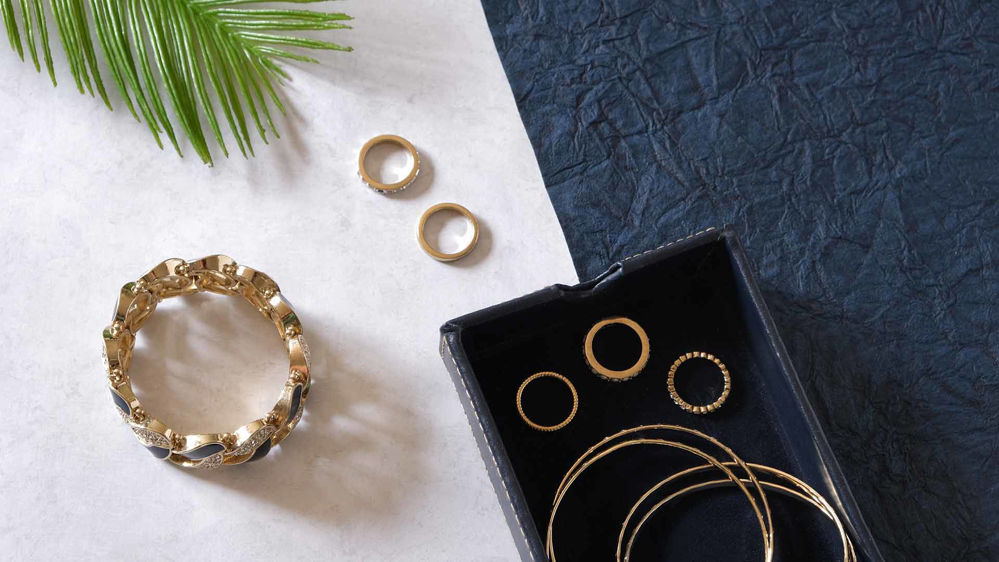
Gold has been treasured for its beauty, rarity, and symbolic value for thousands of years, making it an enduring material for jewelry and decorative arts. From ancient times to the present day, gold has played a significant role in artistic traditions around the world.
In ancient Egypt, gold was believed to be the flesh of the gods, and it was used extensively to create intricate jewelry and decorative objects. The pharaohs wore elaborate gold necklaces, bracelets, and headdresses, and gold was used to adorn everything from furniture to funerary masks.
During the Middle Ages and Renaissance, gold remained a highly valued material for decorative arts. Goldsmiths created intricate filigree work, using thin gold wires to create delicate patterns and designs. Gold was also used to create luxurious objects such as chalices, reliquaries, and caskets.
In the Baroque and Rococo periods, gold was used in abundance in the decoration of palaces, churches, and other public buildings. Gold leaf was used to embellish architectural elements such as ceilings, moldings, and sculptures. Gold was also used in the creation of extravagant decorative arts, such as gilt furniture, mirrors, and clocks.
In the 19th and 20th centuries, gold continued to be an important material in the creation of jewelry and decorative arts. The Art Nouveau movement, which emerged in the late 19th century, embraced the use of natural forms and materials, including gold. Art Nouveau jewelers created highly stylized pieces that featured flowing lines and intricate designs, often incorporating precious stones and enamel.
In the 20th century, gold continued to be an important material in the creation of jewelry and decorative arts, particularly in the Art Deco movement. Art Deco designers favored geometric shapes and bold colors, often using gold as a backdrop for diamonds and other precious stones.
Today, gold remains a popular material in the creation of jewelry and decorative arts. Its durability and malleability make it ideal for creating intricate designs, and its value and rarity make it a desirable material for luxury goods. Gold is often used in combination with other materials such as diamonds, pearls, and colored gemstones to create unique and valuable pieces.
Beyond its use in jewelry and decorative arts, gold also has practical applications in fields such as medicine and electronics. Gold's conductivity and resistance to corrosion make it an important material for use in electronics, including circuitry and computer chips. In medicine, gold is used in the treatment of certain types of cancer and in diagnostic testing.
In addition to its use in decorative arts, gold has been a popular choice in architecture and interior design throughout history. Its ability to withstand corrosion and oxidation make it a durable and long-lasting material for use in building facades, domes, and other decorative elements. One notable example of gold in architecture is the Dome of the Rock in Jerusalem. Completed in 691 CE, the dome is covered in gold leaf, making it a prominent feature of the city's skyline. Similarly, the Golden Temple in Amritsar, India, is covered in over 750 kg of gold, symbolizing the spiritual importance of the metal in Sikhism.
In recent years, there has been a growing interest in ethical and sustainable practices in the jewelry industry, including the use of responsibly sourced gold. Several initiatives have been launched to promote responsible gold mining, such as the Fairtrade Gold certification, which ensures that miners receive fair prices and work in safe conditions, and the Responsible Jewellery Council, which sets standards for responsible sourcing and supply chain transparency.
As the world continues to evolve and demand for ethical and sustainable products increases, the jewelry industry is likely to continue to prioritize responsible sourcing and production practices, including the use of recycled gold and alternative materials.
In conclusion, the use of gold in jewelry and decorative arts has a long and rich history, spanning thousands of years and encompassing numerous artistic traditions. From the elaborate gold jewelry of ancient Egypt to the intricate filigree work of the Renaissance and the bold designs of the Art Deco movement, gold has played a prominent role in the development of artistic styles around the world. Today, gold continues to be highly valued for its beauty, rarity, and enduring appeal, making it a cherished material in the world of art and design. As the industry moves towards more responsible and sustainable practices, the use of gold in jewelry and decorative arts is likely to continue to evolve, but its timeless beauty and allure will endure.
Author: Pooyan Ghamari
Pooyan Ghamari is a Swiss economist and expert in high-tech technology, with a particular focus on the gold sector. He has extensive experience in the fields of artificial intelligence (AI), machine learning, and data analytics, and has worked with a range of organizations in the gold sector.
Ghamari is a thought leader in the field of AI and has published numerous articles and papers on the subject, specifically in relation to its application in the gold sector. He is particularly interested in the ethical and social implications of AI in gold mining, and is committed to advancing the responsible and ethical use of these technologies in the sector.
Ghamari is also a recognized expert in the field of high-tech technology and has advised a range of companies and organizations in the gold sector on how to harness the power of technology to drive innovation and growth. He is passionate about helping businesses and individuals in the gold sector leverage technology to achieve their goals and is a frequent speaker at conferences and events.
In addition to his work in AI and high-tech technology in the gold sector, Ghamari is also a committed advocate for social justice and human rights. He believes that technology can play a powerful role in promoting social change in the gold sector and is dedicated to using his expertise to make a positive impact in the world.
Overall, Pooyan Ghamari is a highly respected and influential figure in the fields of AI, high-tech technology, and the gold sector. His insights and expertise are highly valued by organizations and individuals in the sector, and his work has helped to shape the development and deployment of technology in a way that is both responsible and ethical.


